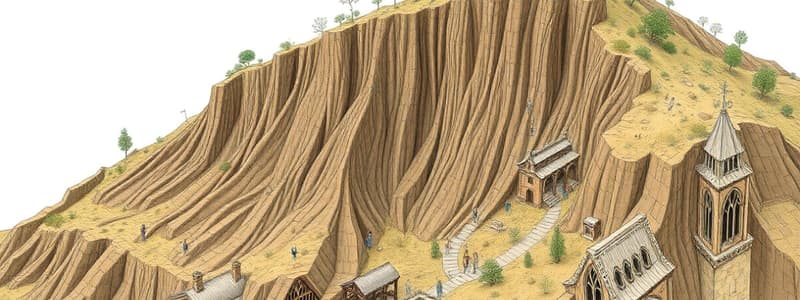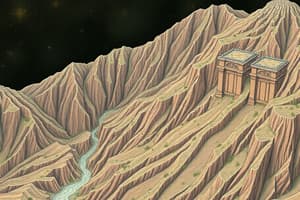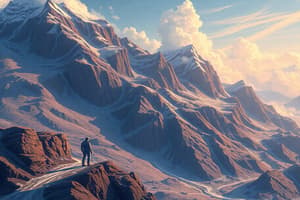Podcast
Questions and Answers
What primarily determines slope stability in mass wasting?
What primarily determines slope stability in mass wasting?
- Slope angle and the strength of underlying material (correct)
- Soil moisture levels and temperature variations
- Human activities and excavation methods
- Surface vegetation and weathering processes
What occurs when the shear force exceeds the normal force on a slope?
What occurs when the shear force exceeds the normal force on a slope?
- Frictional resistance becomes negligible
- Shear strength increases significantly
- Downslope movement occurs (correct)
- The block remains stationary and stable
Which type of mass wasting would involve a rapid movement of soil and rock?
Which type of mass wasting would involve a rapid movement of soil and rock?
- Debris flow (correct)
- Slump
- Soil liquefaction
- Creep
What effect does increasing the slope angle have on shear strength?
What effect does increasing the slope angle have on shear strength?
Which of the following areas would be most susceptible to hazardous mass-wasting events?
Which of the following areas would be most susceptible to hazardous mass-wasting events?
What is the primary mechanism that leads to the movement of material in rotational landslides?
What is the primary mechanism that leads to the movement of material in rotational landslides?
Which characteristic is NOT commonly associated with landslide displacement?
Which characteristic is NOT commonly associated with landslide displacement?
What type of mass wasting event are sturzstroms specifically known for?
What type of mass wasting event are sturzstroms specifically known for?
What distinguishes debris flows from earthflows?
What distinguishes debris flows from earthflows?
Which of the following is an effect of soil creep in an area?
Which of the following is an effect of soil creep in an area?
What happens to the shear force and normal force when a slope becomes slightly steeper than the angle of repose?
What happens to the shear force and normal force when a slope becomes slightly steeper than the angle of repose?
What primary factor can significantly alter the angle of repose for sandy materials?
What primary factor can significantly alter the angle of repose for sandy materials?
Which type of bedding plane poses the greatest risk for instability on a slope?
Which type of bedding plane poses the greatest risk for instability on a slope?
What is the most common trigger for mass-wasting events?
What is the most common trigger for mass-wasting events?
Which of the following methods is NOT typically used to mitigate landslides?
Which of the following methods is NOT typically used to mitigate landslides?
Flashcards are hidden until you start studying
Study Notes
Slope Strength
- Mass wasting occurs when a slope fails due to instability
- Slope stability relies on slope angle and material strength
- Gravity's force on a slope can be divided into shear and normal force
- Shear force pushes material downslope; normal force provides resistance - friction
- Shear strength is the relationship between shear and normal force
- Stable slopes have higher normal force (friction) than shear force
- Steeper slopes increase shear force and decrease normal force, compromising shear strength
- Angle of repose is the steepest angle at which material remains stable
- Angle of repose varies based on factors like grain size, composition, and water content
- Water in pore spaces can increase or decrease shear strength
- Water added to dry sand increases the angle of repose but too much water reduces shear strength
- Planes of weakness in sedimentary rocks, like bedding planes, can affect stability
- Bedding planes parallel to the slope are unstable; perpendicular to the slope are stable
- Clay minerals along bedding planes can absorb water, making the surface slick and impacting shear strength
Mass-Wasting Triggers & Mitigation
- Triggers can be natural, like snowmelt, rainfall, earthquakes, or human activities, like grading
- Increased water content is the most common trigger
- Intense rainfall, especially during El Niño, can increase water content and likelihood of landslides
- Changes in surface water due to earthquakes or human structures can contribute to landslide triggers
- Oversteepened slopes can also cause landslides, due to natural erosion or human development
- Mitigation efforts often involve diverting and draining water from prone areas
- Tarps and plastic sheeting are used to prevent water infiltration into slopes
- Drains and shallow wells monitor water content in active landslides
- Slope reinforcement techniques include bolting, shockcrete, buttressing, and terracing
- Bolting secures loose rock material in prone areas
- Shockcrete strengthens slopes by applying reinforced concrete
- Buttressing adds weight at the toe of the slope and removes weight from the head to stabilize it
- Terracing creates stairstep topography for slope stabilization, but needs proper scaling
- Shielding, catching, and diverting runout material can also mitigate landslides
- Stretchable fencing protects pedestrians and vehicles in rockfall areas
- Runout channels, diversion structures, and check dams slow debris flows and divert them
- Some highways have tunnels to divert landslides over roadways
Landslide Classification & Identification
- Landslides are classified by movement type (falls, slides, flows, creep) and material type (rock, debris, earth)
- Common morphological features include: head scarp, hummocky surfaces, talus accumulations, toe of slope
- Falls are abrupt rock movements, influenced by gravity, weathering, and water
- Rotational slides exhibit slow movement along a curved rupture surface
- Translational slides involve rapid movement along a plane of weakness
- Flows are rapid movements with abundant water, categorized as debris flow (coarse material) or earthflow (fine material)
- Creep is a very slow, downward movement caused by freeze/thaw cycles in unconsolidated material
- Solifluction is a specific type of soil creep in high-latitude regions due to seasonal freezing and thawing
Landslide Parts
- Landslides show displacement of material, causing a gap uphill and deposition downhill
- Tilted or offset structures or natural features can indicate landslide activity
- Scarps or escarpments are steep terrain formed due to movement exposing subsurface material
- The main scarp marks the uphill limit of the landslide and is the visible part of the slide rupture surface
- The slide rupture surface is the boundary between moving and stationary material
- The flanks of the landslide mark the sides of the rupture surface
- The toe of the landslide is at the end of the moving material and indicates the runout distance
- Rotational landslides often create a large, disturbed mound of material at the toe
- Extensional cracks, sag ponds, hummocky terrain, and pressure ridges can be features of landslides
Landslide Examples
- Gros Ventre, Wyoming (1925): 38 million cubic meters of sandstone slid, damming the Gros Ventre River, creating Slide Lake.
- Factors: Heavy rains and snowmelt saturated the sandstone, river undercut the slope, poorly drained soil
- Parallel bedding planes between sandstone and shale contributed to instability due to low friction
- Madison Canyon, Montana (1959): Magnitude 7.5 earthquake triggered a rock avalanche damming the Madison River, forming Quake Lake
- Foliation planes of weakness in metamorphic rock parallel to the surface reduced shear strength
- Mount Saint Helens, Washington (1980): Magnitude 5.1 earthquake triggered the largest landslide in recorded history followed by a volcanic eruption and lahars
- La Conchita, California (1995 and 2005): Earthflows and debris flows in the same location caused damage and fatalities
- Triggers: Heavy rainfall, rising groundwater levels, saturated soil
- Oso Landslide, Washington (2014): 18 million tons of material moved, killing 43 people in the Steelhead Haven community
- Unusually wet winter conditions contributed to the landslide in an area previously prone to smaller events
- Yosemite National Park Rock Falls: Steep cliffs cause frequent rock falls due to tectonic fractures, exfoliation, and frost wedging
- Runout modeling helps assess the risk these falls pose to park visitors
Landslides in Utah
- Markagunt Gravity Slide (21-22 million years ago): One of the largest landslides in geologic history, displacing 1,700 cubic km of material
- Evidence: Breccia conglomerates, pseudotachylytes, slip surfaces, dikes
- Likely triggered by an eruption-related earthquake releasing material from a growing laccolith
- Thistle Slide (1983): Slow-moving landslide blocked Spanish Fork Canyon, causing flooding and submerging the town of Thistle
- Required expensive flood control measures and infrastructure relocation
- Rockville Rock Fall (2013): 2,700 ton block of conglomerate fell from a cliff, destroying a house and killing two people
- Demonstrates the potential hazards of rock falls in steep areas### Mass Wasting
- Downhill movement of rock and soil due to gravity
- Occurs when a slope's angle is too steep for stability
- Regolith (loose rock and soil) is usually what moves
Slope Stability
- Angle of slope and shear strength of materials are key factors
- Steep slopes have a higher risk of mass wasting
Triggers
- Changes that might destabilize slopes
- Common triggers include:
- Rapid snow melt
- Intense rainfall
- Earthquakes
- Volcanic eruptions
- Storm waves
- Stream erosion
- Human activities
- Excessive precipitation is the most frequent trigger
Mass Wasting Events
- Classified by their type of movement and the material involved
- Share common surface features
- Common types:
- Rockfalls
- Slides
- Flows
- Creep
- Movement can range from slow to very rapid
Susceptibility to Mass Wasting
- Areas with steep topography and frequent rainfall are at higher risk:
- California Coast
- Rocky Mountain Region
- Pacific Northwest
Examples of Mass Wasting Events
- North Salt Lake Slide (2014)
- Rotational landslide that destroyed a home and damaged tennis courts
- Likely caused by a combination of:
- Sands and gravels overlying clay
- Recent regrading of the slope
- Heavy rains triggered the event
- Bingham Canyon Copper Mine Landslide (2013)
- 65 million cubic meters of mine wall slid into the pit
- One of the largest non-volcanic landslides in history
- Radar systems warned of movement, preventing major loss of life
- Other Notable Events
- 1996 - Residents in a subdivision near North Salt Lake started noticing damage to their homes. By 2012, 18 homes had become uninhabitable and were removed
- Gros Ventre Landslide (1925) - Large rockfall in Wyoming that created a lake
- Hebgen Lake Earthquake (1959) - Landslides were triggered by a magnitude 7.5 earthquake
- La Conchita Landslides (1995 and 2005) - Landslides in California that killed people
- Oso Landslide (2014) - Landslide in Washington that killed 43 people
- Markagunt Gravity Slide - Ancient landslide in Utah
- Thistle Landslide (1983) - Landslide in Utah that dammed the Spanish Fork River
- Rockville Rockfall (2013) - Rockfall in Utah that destroyed a house
Lessons Learned
- Studying historical events helps scientists predict future events
- Researchers gain knowledge about locations, potential impact, and ways to protect people.
Studying That Suits You
Use AI to generate personalized quizzes and flashcards to suit your learning preferences.




